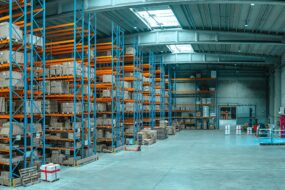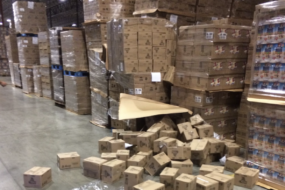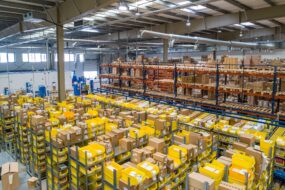Contents

Distribution logistics are key to the success of any e-commerce business. If your products don’t reach customers quickly and in good shape, you won’t have a successful business.
But the process of getting goods to customers isn’t simple. It involves many levels of planning and management of the movement of goods from the company to customers. There are many details to consider with distribution logistics as well as many things that can go wrong.
What Is Distribution Logistics?
In a nutshell, distribution logistics is the link between company and customer. Without it, goods simply don’t reach customers, and the business fails.
Distribution logistics touches every single process involved in the distribution of the products. For direct-to-consumer businesses, this begins with a manufacturer or supplier delivering finished products to the distribution center or specific retail business. Then, the orders are filled. Finally, the packages are shipped out to customers.
This entire process — from manufacturer or supplier all the way to customer — makes up distribution logistics.
What Is a Sales Logistician?
A sales logistician manages distribution logistics. Essentially, this person ensures that orders are fulfilled accurately and on time, resulting in profit for the company.
This professional manages relationships with all third parties involved in the distribution process, ranging from warehouse teams to shipping carriers. They ensure that the entire distribution process is done well in a cost-effective and time-efficient manner.
A sales logistician must predict market demand for products, providing the data other professionals need to manage inventory. This ensures items won’t be out of stock when customers order them.
Goals of Distribution Logistics
Distribution logistics can ensure that your products reach your customers in a timely and safe manner. The primary goals are to reduce mistakes in order fulfillment, lower overhead costs associated with order fulfillment, and ensure product availability, so items are in stock when customers order them.
Types of Distribution: Direct vs. Indirect
For most online businesses, there are two primary means of distribution. Direct distribution means the manufacturer is doing distribution in-house, whereas with indirect distribution retailers or wholesalers distribute or sell the products. Basically, with indirect distribution, third parties or intermediaries are involved.
If your online business does direct distribution, you are responsible for filling orders, inventory storage, packaging, and order shipment. You’ll need efficient processes for each of these hefty tasks.
If your business does indirect distribution, you outsource your order fulfillment to a third party. This means you don’t have to deal with warehousing, picking, packaging, shipping, and tracking orders.
With direct distribution, you work with your customers more directly, which can be a benefit as you build customer relationships. Because you manage every aspect of the distribution process, you can spot areas that need improvement and make changes quickly.
With indirect distribution, you don’t have to worry about all the details and management of the distribution process. You can save overhead on storage costs, and you benefit from the experience and infrastructure of the third-party fulfillment provider you’re using.
Many e-commerce businesses start with direct distribution, but as operations grow, they move to indirect distribution. It’s a matter of looking at your distribution needs and your costs, and determining what makes the most sense for your business.
Current Distribution Challenges
The COVID-19 pandemic affected virtually every area of life, and we’re still feeling the repercussions. Supply chains were greatly affected as borders were closed, resulting in manufacturing delays, higher shipping rates, and delivery interruptions.
Because of the pandemic, new safety and hygiene protocols have been implemented in warehouses. All of this takes time and slows the fulfillment process.
And it doesn’t look like supply chain issues are improving in the short term. Shortages of raw materials and certain parts are expected to continue as various other factors play in, such as Russia’s invasion of Ukraine.
These challenges make it all the more important to make sure your distribution logistics are in good shape. You’ll need to predict how shortages and supply chain problems will impact your distribution process and plan accordingly.
You may also consider working with local suppliers and manufacturers. This can streamline the procurement process and save money on transport fees.
Use Technology to Improve Distribution Logistics
Distribution involves many different individual processes, so it can be a lot to manage. With strategic planning and implementation, you can improve your business’s distribution logistics. The right technology is the best way to simplify the process.
Software solutions can manage everything from your inventory to orders. These tools provide robust tracking capabilities, helping to reduce order errors and ensure customers receive their orders swiftly. You can also have visibility on the entire process, allowing you to identify trouble spots and implement improvements quickly.
Logistipedia Can Help You Improve Your Distribution Logistics
We help businesses optimize how they move their goods around the world. We’re experts in every aspect of the distribution process. Let us help your business take charge of your distribution logistics today.
Distribution Logistics FAQs
What are distribution logistics?
Distribution logistics is the process of moving goods from manufacturer or supplier to customer.
What is the difference between logistics and distribution?
Logistics generally refers to the overall management of the movement, storage, and inventory organization of goods, whereas distribution refers to the movement or placement of goods. Logistics and distribution work hand in hand.
What will a good distribution logistics strategy entail?
A good distribution logistics strategy will aim to optimize costs, time, and efficiency in relation to the movement of goods.
References
What Is Direct Distribution? Definition and Benefits. (August 2021). Indeed.
Why the Global Supply Chain Mess Is Getting So Much Worse. (March 2022). CNN.
Why the Pandemic Has Disrupted Supply Chains. (June 2021). The White House.
Product Shortages and Soaring Prices Reveal Fragility of U.S. Supply Chain. (April 2022). CBS News.




